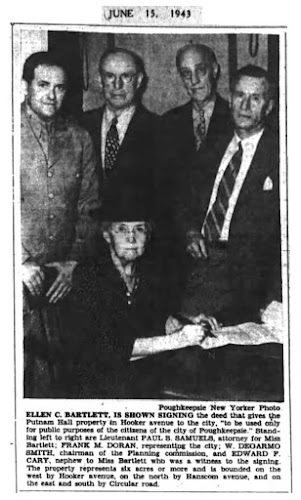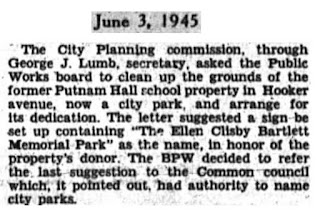"Mary Bryan Johnson was its founder. She and her future husband, Edward White, erected a building on six acres of elevated grounds in the southeastern section of Poughkeepsie at the corner of what then was Southeast and Hanscom Avenues."
"While there are a great many schools of a high order in most respects, probably there are few that equal, and fewer still that as a whole excel, the Brooks Seminary at Poughkeepsie, New-York, a city on the Hudson, of extraordinary advantages in many respects, more especially as to health.
"Next door to Vassar, both in location and standing, and in some sort a preparatory school, it in some respects excels, and many would deem it superior to, that great institution."
 According to "The Eagles History of Poughkeepsie" by Edmund Platt, after Brooks Seminary vacated the building, it was used as hotel and as a dormitory for Vassar students. In 1901, however, Ellen Clizbe Bartlett and Frances A. Welbasky established a new boarding school for women at this location, renaming it the Putnam Hall School. It's unclear who the school was named after. Putnam County of New York was named after Israel Putnam, a Revolutionary War hero. There was also another hero of the Revolution, Israel's cousin Rufus Putnam, who was appointed by George Washington in 1776 as the nation's first Chief Engineer. In this position Rufus helped design the fortifications of Fort Putnam and West Point in New York. It seems highly unlikely that a boarding school for women would be named after one of these long-dead military men. I'm guessing the school was named in honor of a rich patron or benefactor named Putnam. Below is a colorized postcard photo of the Putnam Hall School, circa 1907:
According to "The Eagles History of Poughkeepsie" by Edmund Platt, after Brooks Seminary vacated the building, it was used as hotel and as a dormitory for Vassar students. In 1901, however, Ellen Clizbe Bartlett and Frances A. Welbasky established a new boarding school for women at this location, renaming it the Putnam Hall School. It's unclear who the school was named after. Putnam County of New York was named after Israel Putnam, a Revolutionary War hero. There was also another hero of the Revolution, Israel's cousin Rufus Putnam, who was appointed by George Washington in 1776 as the nation's first Chief Engineer. In this position Rufus helped design the fortifications of Fort Putnam and West Point in New York. It seems highly unlikely that a boarding school for women would be named after one of these long-dead military men. I'm guessing the school was named in honor of a rich patron or benefactor named Putnam. Below is a colorized postcard photo of the Putnam Hall School, circa 1907:In the early 20th century, the Putnam Hall School and Miss Bartlett were held in high regard, both locally and nationally. As such, when Miss Bartlett announced her intention to close the school on May 31, 1912 due to financial difficulties, it was news coast to coast:
Locally, the reaction to Miss Bartlett's announcement was swift. On April 15, 1912, the Poughkeepsie Eagle News reported that "Prominent Men" were going to try and save the school:
It's not clear who these "prominent men" were, but the results they achieved were spectacular. As reported in the Poughkeepsie Eagle-News on September 23, 1912, the school was out of financial difficulties and had been"greatly improved for the fall term":The school continued to operate through the 1933 school year but then closed abruptly, possibly due to Miss Bartlett's retirement. In 1940, the school was torn down and, a few years later, Miss Bartlett deeded the property to the city with the stipulation that it be "used only for public purposes by the citizens of the city of Poughkeepsie". The event was captured in the photo, below, in the June 15, 1943 edition of the Poughkeepsie Journal:
On March 16, 1944, Ellen Clizbe Bartlett died at the age of 87. Her obituary was carried in the New York Times:
Creating the ParkAlmost immediately, the local government took action to utilize Miss Bartlett's gift to the city. As shown in the article below from the Poughkeepsie Journal, the Department of Public Works was asked to clean up the grounds, plans were made for a dedication ceremony and the Planning Commission suggested that a sign proclaiming the area as "The Ellen Clisby Bartlett Memorial Park" be erected. The fact that the Poughkeepsie Journal misspelled Miss Bartlett's middle name indicates that perhaps the park needed a simpler name.
As stated in the article, the Planning Commission didn't have the authority to name the park, so the issue was transferred to the Common Council. They, in turn, transferred it to the Public Property Committee, suggesting that it be called "The Ellen Clisbie Bartlett Memorial Park", again misspelling her middle name.Apparently, though, little was actually done to create a functioning park. On June 27, 1947, the headline of the Poughkeepsie Journal indicated that the area might become the location of the new Poughkeepsie High School.
Seven years later, a 1954 Poughkeepsie Journal article stated that the Board of Directors of the Jewish Community Center agreed that Bartlett Park would be "acceptable .. in exchange for its College Avenue property which has been designated as part of a site for a new Poughkeepsie High School".
On February 20, 1958, a Poughkeepsie Journal article made it very clear that very little had been done to create a functioning park. A former alderman, Mrs. Cummins, proposed that the city give back the site to the heirs of Miss Bartlett who could then sell the land for housing:
In 1961, the city considered using Bartlett Park as the site for its new YMCA:
A sign identifying the area as Bartlett Park would not be erected until a decade later.
Postscript
Two final points worth mentioning. First, even though the area was officially referred to as Bartlett Park (or a variation thereof) since 1943, those who visited the park well into the 1970's always called it Putnam Park. Even the Poughkeepsie Journal occasionally referred to it as Putnam Hall Park:
Not the type of documentation I was looking for, but I'll take it.
















